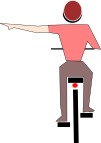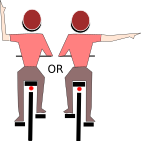Chapter 7: Safe Driving Strategy
See-Think-Do Strategy:
See:
- Scan your surroundings: Keep your eyes moving and observe what’s happening ahead, beside, and behind your vehicle.
- Look ahead: Focus on the road ahead to anticipate potential hazards (e.g., pedestrians, other vehicles, road conditions).
- Use peripheral vision: Be aware of what’s beyond your direct line of sight.
Think:
- Assess hazards quickly: Identify potential risks (e.g., a car suddenly braking, a pedestrian stepping onto the crosswalk).
- Prioritize: Determine which hazards are most dangerous and require immediate attention.
- Decide on the safest action: Consider braking, steering, or adjusting your speed.
Do:
- Execute safe maneuvers: Act promptly based on your analysis. Brake smoothly, steer away from danger, or adjust your position within the lane.
Observation:
- Looking ahead: Scan at least 12 seconds ahead (about one block in city driving) to anticipate traffic flow, intersections, and obstacles.
- Observing beside: Check side mirrors and blind spots for adjacent vehicles and cyclists.
- Watching behind: Use rear-view mirrors to monitor traffic approaching from behind.
- Keep your eyes moving: Complete the observation cycle every 5 to 8 seconds to stay aware of changing conditions.
- In city driving, scan 1 to 2 blocks ahead to anticipate traffic flow, signals, and potential hazards.
- On highways, look half a kilometer ahead to prepare for merging, lane changes, and exits.
- Also scan left and right to monitor side areas (e.g., pedestrians at crosswalks, vehicles turning).
- Rear-View Mirrors: Adjust your rear-view mirror to get the best view of what’s behind you. Check the rear-view mirror before slowing down or stopping. Ensure that cars behind you have enough space to stop safely.
- Side-View Mirrors: Use side-view mirrors when changing your road position or direction. When pulling away from the right side of the road, check the left mirror for any approaching vehicles. Before making a lane change to the right, verify there’s enough space using the right mirror.
- Blind Spots: Even with properly adjusted mirrors, blind spots exist—especially to the side. Be cautious when changing lanes or merging—do a shoulder check to clear blind spots.
- Shoulder Checks: Whenever changing direction or position, perform a shoulder check. For example, before turning right, quickly check to the right to ensure no one is in your blind spot. Also, check mirrors and do a shoulder check before opening your door to exit—cyclists or vehicles may be nearby.
Observing at Intersections:
- Look Ahead: Scan for signs, signals, and clues about stopping. Check crosswalks you intend to cross.
- Stopping and Starting: Slow down, check mirrors. Ensure a clear view of the intersection. Move slowly if your view is blocked.
- Turning: Shoulder check. Scan the intersection as you start moving. Keep eyes in the desired direction during the turn.
Space Conflicts:
Space conflicts refer to situations on the road where there isn't enough room for drivers to move safely, leading to potential collisions or hazardous conditions. These conflicts can occur in various driving scenarios such as:
- Following Too Closely: Not maintaining a safe distance between vehicles.
- Merging and Lane Changes: Insufficient space to move into another lane safely.
- Intersections: Failing to yield right-of-way, running red lights or stop signs.
- Passing: Not having enough space to pass another vehicle safely.
- Parking: Not having enough room to park without hitting other vehicles or objects.
Speed Control:
- Choose speeds based on conditions, not just posted limits. Ideal speed varies with road conditions (slippery roads, limited visibility). Common speed limits: 50 km/h in cities, 80 km/h outside cities, and 20 km/h in lanes or alleys within municipalities.
- Smoothly use brakes and accelerator. Avoid abrupt stops (e.g., approaching stop signs). Anticipate hazards and slow down gradually.
- Handling Curves: Slow down before curves to manage inertia and traction. Avoid braking in the curve to prevent skidding, especially on slippery or uneven roads. If you lose traction, ease off the accelerator and reapply gently when traction is regained.
Controlling the Wheel:
- Hand Placement: Both hands on the outside of the wheel. Position hands at 9 o’clock and 3 o’clock or 10 o’clock and 2 o’clock. Consider airbag safety (avoid 10 o’clock and 2 o’clock).
- Steer smoothly to minimize side-to-side movement. Look ahead in the desired direction. Focus ahead during turns for smooth arcs.
Space Margins:
- Tailgating Risks: Following too closely (tailgating) is a major cause of crashes. It blocks your view of hazards ahead. Sudden stops can lead to rear-end collisions.
- Total Stopping Distance: Includes perception time (see-think) and reaction time (do). Allow enough space to react and slow down safely.
- Two-Second Rule: Maintain at least two seconds of space in front (good weather). Increase to three seconds on high-speed roads and four seconds in bad conditions. Adjust for large vehicles, motorcycles, and following distances.
- Lane Position:
- On a two-lane road:
- Stay close to the center line to prevent other vehicles from encroaching into your lane.
- In the curb lane, avoid hazards (e.g., car doors opening).
- Generally, drive near the center of the lane. Avoid blind spots of other drivers.
- On a multi-lane road:
- The right lane is often safest (away from oncoming traffic and less tailgating risk).
Communication:
Turn Signals:
- Use turn signals for turns, lane changes, and pulling over. Signal well ahead to give others warning. Be clear and cancel the signal after turning. In hard-to-see situations, use hand signals alongside automatic turn signals.
- Left Hand Signal: Extend your left arm straight out the window
- Right Hand Signal: Extend your left arm out the window and bend it upwards at a 90-degree angle.
- Hand Signal for stop: Extend your left arm out the window and bend it downwards at a 90-degree angle.



Lights for Communication:
- Brake Lights: Indicate slowing down or stopping.
- Backup Lights: Show reverse movement.
- Hazard Lights: Used for emergencies or slow travel.
Horn:
- Use the horn to alert others of your presence and prevent accidents. Only use it for useful signals to avoid collisions.
Eye Contact:
- Make eye contact with pedestrians and other road users. Establish safety for crossing or proceeding.